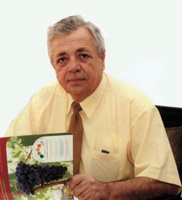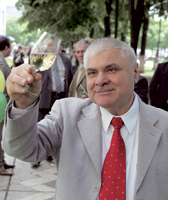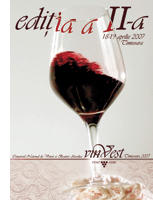World Roumania
Special Roumania

Mr Nicolae Grigoreanu - Ministre Conseiller - Ambassade de Roumanie
"“If Romania did not exist, we would have to invent it!”…"It offers so much diversity, so many astounding features and magnificent landscapes; the people are so hospitable and cheerful that each time a visitor returns to Romania, he never ceases to be surprised at rediscovering this marvellous country.
Over the centuries, Romania has suffered many upheavals and hard times, but Romanians have always cleverly adapted, increasing this country’s wealth of customs and the warmth of its welcome. Our abundant lowlands, crossed by rivers, our mountains that conceal so many legends hidden in the shadows of pine trees and castles, the splendid Danube Delta, with its extremely rare biodiversity, the unsung beauty of the Black Sea, and our elders, always so ready to recount you mysterious tales. All these aspects represent the treasures of our country and any Romanian will talk endlessly about them.
But Romania’s true wealth does not end here! Located on the geographical border of the European Union, Romania has always been a crossroads of civilisations; this is clearly shown by its language, traditions and gastronomy. There are still a number of minorities in Romania; they each continue to protect their identity and traditions, but contribute to the rich cultural tapestry of this country. A recurring characteristic amongst them all is a sense of hospitality. There are many households where a hungry stranger will be welcomed to eat with the family; the traveller will continue his journey, taking with him his hosts’ recommendations and good wish: “Drum bun!” (“Have a safe journey!”). To seal friendship, any encounter of this kind is always accompanied by a glass of spirit or wine.
Vine growing has existed in our country for 4 000 years. Romanian wine, known as “Dacia” during the pre-Roman and Roman era, was so greatly treasured that the High Priest Deceneu advised Dace King Burebista (1st century A.D.) to destroy all the vines in Romania to prevent invasions from migratory populations. But winegrowing never vanished and experienced a revival during Dacia’s period of Roman occupation, flourishing with the help of climatic and geological blessings bestowed by Nature. These days, Romania figures amongst the 10 leading wine-producing countries worldwide, with 200 000 hectares under vine and a wide range of high quality native and imported grape varieties.
Vineyards are dotted almost all over Romania, and in rural areas each household produces its own supply of wine.
The future of wine production looks bright, all the more so since Romanian wine has received several awards at numerous international competitions. As a result of its success, wine was acknowledged in 2005 as a product of strategic importance by the Romanian Minister of Agriculture & Rural Development and the Department for Foreign Trade.
On January 1st 2007, Romania resumed its rightful place amongst Latin-civilisation countries and its friends in the European Union, therefore completing Europe’s cultural and economic identity. Romania’s astounding beauty and diversity have waited to be revealed for so many years and are now accessible to all. Visitors are welcomed as friends and offered a wide choice of possibilities for their visit: the UNESCO Heritage route, the Monuments of Nature route, the Medieval Towns route, the Wine route …
We hope to welcome you soon in Romania ….

Roumania: its wines, its history and its futureAccording to the historian Alexandru Xenopol, the worship of Dionysus finds its origins on the banks of the Danube, where the Geto-Daces tribes, ancestors of the Romans, devoted their energy to vine growing.
In numerous accounts, Alexandru Xenopol tells us that during its period of Roman occupation, Dacia was symbolically represented by the Roman Emperor Trajan; he ordered the minting of Dacia-Felix coins, showing a woman carrying two children in her arms; one bearing a bunch of grapes, the other a sheaf of wheat.
Over the centuries, vines have been selected to ensure superior standards, suitable production areas have been delimited and wine-making methods improved; all these factors have contributed to re-establishing Romania as a fine quality wine-producing country.
A series of devastating and negative events led to Romania’s disappearance from the worldwide scene of fine wines: first the scourge of Phylloxera in 1884, then the First and Second World Wars and more recently the “Soviet style” political regime that prevented vine growers from working with their own vines.
In the past, the main native Romanian grape varieties were: the Feteaskas, Alba, Regala and Neagra, Grassa de Cotnari, Tamaioasa Romaneasca, Busuioaca de Bohotin, Francusa de Cotnari, Bâbeascâ Neagra, Negru de Dragasan and Novac.
The beginning of a bright future
In 1989, after one hundred years of absence, growers were once again allowed to tend the vines they so dearly loved and had never forgotten. A new era was just beginning …
Every detail of this viticultural revival had to be taken from scratch though, because during the Soviet period high yielding, inferior quality vines had been planted; 70% white and 30% red. The wines produced were sold essentially to Russia.
This new period of Romanian vine growing has involved replanting vineyards, mainly with imported varieties of red grape vines, but also some typically Romanian native varieties. Since 1989, a large number of foreign investors (German, Austrian, Italian and British) have bought vineyards in Romania’s eight main wine-producing areas, which cover a total of 50 appellations.
A renewal of quality for these wines
The 270 000 hectares of the current winegrowing area generate an annual production of 6.5 million hectolitres, approximately half of which are used for making quality wines. Romania figures amongst the 10 leading wine-producing countries worldwide.
Romania possesses a genetic heritage of historical, native varieties; they are a testimony of its ancient wine-making tradition and are used in conjunction with imported varieties, thus ensuring the future of superior quality wines.
Located on the same latitude as France, with weather conditions that vary from one region to another and endowed with a range of different soil types, Romania offers wines of great diversity.
A decree adopted by Parliament on September 29th 1998 determined Romania’s various production areas, established along the same lines as the INAO (National Institute for AOCs) system in France.
The commitment of viticultural and oenological analysis centres, as well as studies carried out by researchers (such as Dr Aurel Popa at the University of Craiova) responsible for this vine growing revival, aim essentially to rekindle intrinsic humanitarian values linked to the land, deeply rooted in the soul of Romanian people, so that wine, a magnificent natural resource representing the history, culture and tradition of an entire nation, may soon become Romania’s leading ambassador worldwide.

 Mihai PATIC - Managing Director - O.N.V.V. - M.A.D.R
Mihai PATIC - Managing Director - O.N.V.V. - M.A.D.R
Author of “The Encyclopaedia of the Vine and Wine” (Ed. “Technica” - Bucarest 2006)
Wine growing in Romania: past, present and futureWith a total area of 210 373 hectares under vine on January 1st 2007, in the list of European wine-producing countries, Romania is classed in 5th position and ranks 9th worldwide. Romania has been a member of the O.I.V. since 1927.
Romania has tremendous potential in this field and will undoubtedly make considerable progress in the future as far as global competition is concerned. To achieve this aim, Romania must optimise and preserve its excellent pedological and climatic conditions in order to produce quality wines. In doing so, it will continue to produce wines that pay tribute to the history of this country.
It is a fact that during the Neolithic era wine was already produced in Dacia, a former Romanian territory. In the past, Dacia’s very “elegant” wines were much admired by the Austro-Hungarian, Russian and Polish Empires; for this reason, these wines were exonerated from customs tax. The most well known Romanian grape varieties are: Babeasca Neagra (Black Lady), Braghina, Crâmposie, Feteasca Neagra (Black Girl), Feteasca Alba (White Girl), Busuioaca de Bohotin, Grasa de Cotnari, Iordana, Tamâioasa Româneasca, Zghihara, etc.
Having recently joined the EU, Romania is now seeking to establish its place amongst other European wine-producing countries. The quality of Romanian wines enables them to compete with those produced on every continent and this fact has been proved by the considerable number of medals they have won at numerous world competitions. Romania produces slightly sparkling and sparkling wines, as well as other beverages made with wine.
The future of Romanian vine growing is being coordinated by a fifteen-year strategic develop plan, which uses other wine-producing countries as its example.
Romania plans to improve the quality of V.D.O.C. wines by setting out the delimitation of areas under vine, to establish geographical indications.
Lastly, Romania intends to specialise in its native grape varieties, to make wines that will be sought-after worldwide.
To conclude, don’t forget: Visit Romania and taste our wines!

Dr Ion Pusca - Dr Engineer - Economist - Oenologist – General Manager
House of Wine - S.C Casa Vinului - Bucharest - www.casavinului-drpusca.ro
Docteur Pusca,
a walking encyclopaedia of romanian wines
One of the leading lights of Romania’s wine world, Dr Pusca is fuelled by passion and enthusiasm to develop and promote Romanian viticulture.
After a distinguished university career and considerable involvement in the domains of oenology, foreign trade and horticulture, Dr Pusca, a man of practical experience, decided to make his own sparkling wine in Panciu.
.Panciu is his family’s native region, an area reputed for its production of Italian Feteaska and Riesling wines. These are the basis for sparkling wines (using the Traditional method), made in subterranean cellars dating back to the medieval era of Etienne Le Grand.
Panciu is an area highly regarded in Romania as well as abroad, due to the marvellous characteristics of its wines.
Dr Pusca is a Francophile and speaks French fluently; he has taken part in several wine-making training courses and conferences in France, and has also attended programmes in Italy and Spain.
His knowledge of ampelography is inexhaustible; he has written numerous books on this subject, which have become references for both Romanian and foreign professionals.
In Dr Pusca’s opinion, the oldest Romanian grape varieties, dating back 2000 years are:
• Grasa Cotnari, originating from Transylvania; it is now grown in the north-eastern part of Romania, in Cotnari-Moldavia. This variety is very similar to the Tokaj Fürmint; it is very sensitive to botrytis, making it ideal for producing sweet white wines.
• and Feteaska Neagra, initially grown in Moldavia, between the Carpates and the Nistre River. This variety is now grown in all the vineyards surrounding the Carpates. An extremely resistant variety, it can produce very full-bodied wines and also extremely light wines; this variation stems differences in soil type, weather conditions and the wine-making methods used. The elegance of this variety can easily be compared with Pinot Noir.
A fascinating, convivial man and an absolute mine of information, Dr Pusca is dedicated to ensuring the future of Romanian viticulture. His talents are regularly solicited by numerous foreign visitors: economists, wine professionals, government representatives and wine trade officials.
So, without actually possessing the title, Dr Pusca could be said to be the Romanian Minister for the Vine and Wine.

Vinvest in Timisoara,
a major international showcase exhibition for romanian wines
At the farthest western point of Romania, in the region of Banat, Timisoara is located in one of the eight leading winegrowing areas of Romania, where vines have been grown since 1374.
Founded by Lucia PIRVU, a passionate oenophile and skilled professional with an extensive cursus in vine growing and wine-making, VINVEST is a major event that brings together Romanian wine professionals.
This exhibition is held annually in March or April and is coordinated by Romanian wine trade organisations: ONIV, ADAR and ONVV.
A nationwide competition, supervised by a jury of experts, is also held during VINVEST. Medals awarded at this occasion are a key reference for wine producers.
The objectives of this event are on a par with the image of Timisoara itself, since it is one of Romania’s principal economic, agricultural and industrial centres.
This extremely active region has been oriented towards export markets for many years, and its proximity with neighbouring countries Serbia and Hungary has contributed to making it one of the most dynamic in Romania.
A visit to VINVEST is clearly essential to understand the true extent of qualities that Romanian wines possess.
Pascale TETOT

 Roumania: its wines, its history and its futureAccording to the historian Alexandru Xenopol, the worship of Dionysus finds its origins on the banks of the Danube, where the Geto-Daces tribes, ancestors of the Romans, devoted their energy to vine growing.
Roumania: its wines, its history and its futureAccording to the historian Alexandru Xenopol, the worship of Dionysus finds its origins on the banks of the Danube, where the Geto-Daces tribes, ancestors of the Romans, devoted their energy to vine growing. 
 Mihai PATIC - Managing Director - O.N.V.V. - M.A.D.R
Mihai PATIC - Managing Director - O.N.V.V. - M.A.D.R  Dr Ion Pusca - Dr Engineer - Economist - Oenologist – General Manager
Dr Ion Pusca - Dr Engineer - Economist - Oenologist – General Manager Vinvest in Timisoara,
Vinvest in Timisoara,